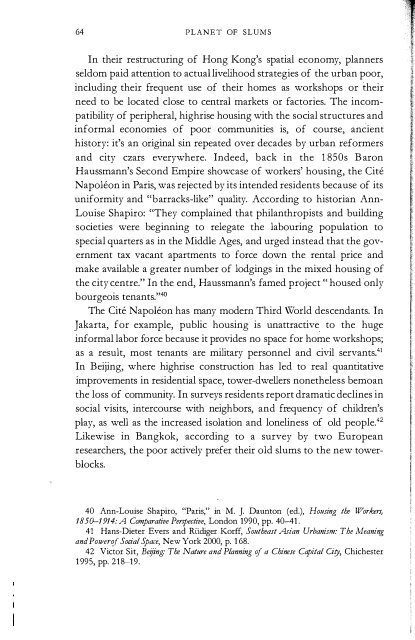Untitled - Rebel Studies Library
Untitled - Rebel Studies Library
Untitled - Rebel Studies Library
You also want an ePaper? Increase the reach of your titles
YUMPU automatically turns print PDFs into web optimized ePapers that Google loves.
64 PLANET OF SLUMS<br />
In their restructuring of Hong Kong's spatial economy, planners<br />
seldom paid attention to actual livelihood strategies of the urban poor,<br />
including their frequent use of their homes as workshops or their<br />
need to be located close to central markets or factories. The incompatibility<br />
of peripheral, highrise housing with the social structures and<br />
informal economies of poor communities is, of course, ancient<br />
history: it's an original sin repeated over decades by urban reformers<br />
and city czars everywhere. Indeed, back in the 1850s Baron<br />
Haussmann's Second Empire showcase of workers' housing, the Cite<br />
Napoleon in Paris, was rejected by its intended residents because of its<br />
uniformity and "barracks-like" quality. According to historian Ann<br />
Louise Shapiro: "They complained that philanthropists and building<br />
societies were beginning to relegate the labouring population to<br />
special quarters as in the Middle Ages, and urged instead that the government<br />
tax vacant apartments to force down the rental price and<br />
make available a greater number of lodgings in the mixed housing of<br />
the city centre." In the end, Haussmann's famed project " housed only<br />
bourgeois tenants. ,, 40<br />
The Cite Napoleon has many modern Third World descendants. In<br />
Jakarta, for example, public housing is unattractive to the huge<br />
informal labor force because it provides no space for home workshops;<br />
as a result, most tenants are military personnel and civil servants.41<br />
In Beijing, where highrise construction has led to real quantitative<br />
improvements in residential space, tower-dwellers nonetheless bemoan<br />
the loss of community. In surveys residents report dramatic declines in<br />
social visits, intercourse with neighbors, and frequency of children's<br />
play, as well as the increased isolation and loneliness of old people.42<br />
Likewise in Bangkok, according to a survey by two European<br />
researchers, the poor actively prefer their old slums to the new towerblocks.<br />
40 Ann-Louise Shapiro, "Paris," in M. J. Daunton (ed.), Housing the Workers,<br />
1850-1914: A Comparative Perspective, London 1990, pp. 40-41.<br />
41 Hans-Dieter Evers and Rtidiger Korff, Southeast Asian Urbanism: The Meaning<br />
and Powerf Social Sp ace, New York 2000, p. 168.<br />
42 Victor Sit, Beijing: The Nature and Planning if a Chinese Capital City, Chichester<br />
1995, pp. 218-19.<br />
I<br />
,<br />
THE TREASON OF THE STATE<br />
' The agencies who plan slum eviction see an alternative for the people in<br />
, the cheap highrise flats: the people in the slums know that eviction and<br />
, life in these flats would reduce their means of reproduction and the pos<br />
, sibilities for subsistence production. Furthermore access to work is more<br />
ifficult due to the location of these flats. This is the simple reason why<br />
the slumdwellers prefer to stay in the slum and are starting to fight<br />
against evictio For them the slum is the place where production under<br />
_<br />
deteri a,g circumstances is still possible. For the urban planner, it is a<br />
mere cancer i ' the city.43<br />
Meanwhile, middle-class "poaching" - as housing experts call it - of<br />
public or state-subsidized housing has become a quasi-universal phenomenon.<br />
Algeria in the early 1980s, for example, began to subdivide<br />
urban land reserves into plots, ostensibly for development by housing<br />
cooperatives; building materials were furnished at subsidized prices. As<br />
architect Djaffar Lesbet observes, however, this theoretically elegant<br />
balance between state aid and local initiative did not democratize access<br />
to housing: "The building plots have allowed those whom the system<br />
privileged to hold onto their lead, to achieve their own housing. They<br />
have also helped to reduce the dramatic and political tone of the<br />
housing crisis, by transforming this national issue into an individual<br />
problem."44 As a result, civil servants and others have acquired subsidized<br />
detached homes and villas, while the truly poor have ended up in<br />
illegal shacks in bidonvilles. Although lacking the revolutionary elan of<br />
Algeria, Tunisia also developed substantial state-subsidized housing,<br />
but 75 percent of it was unaffordable by the poor, who instead<br />
crowded into Tunis's sprawling slums such as Ettadhamen, Mellassine,<br />
and Djebel Lahmar.45<br />
India illustrates the same trend in several different guises. In the<br />
1970s, for example, municipal and state authorities launched a hugely<br />
ambitious scheme to create a modern twin city on the mainland,<br />
opposite the Bombay peninsula. The urban poor were promised new<br />
homes and jobs in glittering New Bombay (now Navi Mumbai), but<br />
43 Evers and Korff, Southeast Asian Urbanism, p, 168,<br />
44 Lesbet, "Algeria," pp. 264-65.<br />
45 Frej Stambouli, "Tunis: Crise du Logement et Rehabilitation Urbaine," in Amis<br />
and Lloyd, Housing Africa} Urban Poor, p. 155,<br />
65


